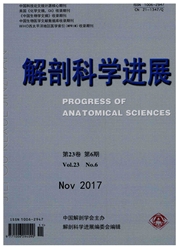

 中文摘要:
中文摘要:
目的研究应用低频超声辐照和小量缓激肽颈内动脉灌注非侵袭性、可逆性、靶向最大限度开放血肿瘤屏障的可行性。方法应用伊文氏兰检测血肿瘤屏障通透性,透射电镜观察吞饮小泡数量,Westernblot法检测质膜微囊结构蛋白caveolin-1和caveolin-2的蛋白表达,RT—PCR法检测caveolin-1和caveolin-2的mRNA表达。结果低频超声辐照联合应用小剂量缓激肽后伊文氏兰检测血肿瘤屏障通透性显著增加(P〈0.01),透射电镜示吞饮小泡数量显著增加(P〈0.01),RT—PCR法、S-P免疫免疫组织化学法、Westernblot法检测质膜微囊结构蛋白caveolin-1和caveolin-2的mRNA和蛋白表达表达显著增加(P〈0.01)。结论低频超声辐照联合应用小剂量缓激肽通过增加胞吞饮转运显著增加血肿瘤屏障通透性。
 英文摘要:
英文摘要:
Objective To study the characteristics of the noninvasive, reversible, targeted opening of the bloodbrain barrier (BBB) by use of low-frequency ultrasound (LFU) irradiation and the selective opening of the blood-tumor barrier (BTB) by intracarotid infusion of bradykinin (BK) in small-dose to explore maximum opening of the BTB by combining LFU irradiation with BK infusion to provide new therapeutic strategies for targeted transport of macromolecular or granular drugs to the brain. Methods Opening of the BTB was detected by Evans blue (EB), the number of pinocytotic vesicles of brain microvascular endothelial ceils (BMECs) in the BTB was observed by transmission electron microscopy (TEM), and changes of expression of the caveolae structure proteins caveolin-1 and caveolin-2 protein and mRNA in BMECs were detected by using RT-PCR, western blot and immunohistochemistry. Results The extravasation of Evans blue (EB) through the BTB was significantly increased by combining LFU irradiation (frequency = 1.0 MHz, power = 12 mW, duration = 20 s) with intracarotid small dose BK infusion, compared with utilizing the two methods separately in rat C6 glioma model. We observed that this combination significantly increased the number of pinocytotic vesicles of BMECs in the BTB under TEM. An even more significant increase was observed by using RT-PCR, western blot and immunohistochemistry to detec changes of expression of the caveolae structure proteins caveolin-1 and caveolin-2 proteins and mRNA in BMECs. Conclusion LFU irradiation and small-dose BK together selectively enhance the permeability of the BTB and increase the number of pinocytic vesicles of BMECs to a maximum, which might be related to the upregulation of caveolae structure proteins caveolin-1 and caveolin-2 expression
 同期刊论文项目
同期刊论文项目
 同项目期刊论文
同项目期刊论文
 Mechanisms for Endothelial Monocyte-Activating Polypeptide-II-Induced Opening of the Blood-Tumor Bar
Mechanisms for Endothelial Monocyte-Activating Polypeptide-II-Induced Opening of the Blood-Tumor Bar Regulation of cellular growth, apoptosis, and Akt activity in human U251 glioma cells by a combinati
Regulation of cellular growth, apoptosis, and Akt activity in human U251 glioma cells by a combinati Vascular endothelial growth factor participates in modulating the C6 glioma-induced migration of rat
Vascular endothelial growth factor participates in modulating the C6 glioma-induced migration of rat Artemether combined with shRNA interference of vascular cell adhesion molecule-1 significantly inhib
Artemether combined with shRNA interference of vascular cell adhesion molecule-1 significantly inhib Green tea polyphenols alleviate early BBB damage during experimental focal cerebral ischemia through
Green tea polyphenols alleviate early BBB damage during experimental focal cerebral ischemia through Effects of poly (ADP-ribose) polymerase inhibitor 3-aminobenzamide on blood-brain barrier and dopami
Effects of poly (ADP-ribose) polymerase inhibitor 3-aminobenzamide on blood-brain barrier and dopami Topoisomerase I inhibitors, shikonin and topotecan, inhibit growth and induce apoptosis of glioma ce
Topoisomerase I inhibitors, shikonin and topotecan, inhibit growth and induce apoptosis of glioma ce Platelet-derived growth factor BB mediates the glioma-induced migration of bone marrow-derived mesen
Platelet-derived growth factor BB mediates the glioma-induced migration of bone marrow-derived mesen Role of RhoA/ROCK signaling in endothelial-monocyte-activating polypeptide II opening of the blood-t
Role of RhoA/ROCK signaling in endothelial-monocyte-activating polypeptide II opening of the blood-t Doxycycline-mediated protective effect against focal cerebral ischemia-reperfusion injury through th
Doxycycline-mediated protective effect against focal cerebral ischemia-reperfusion injury through th Low-Frequency Ultrasound Irradiation Increases Blood-Tumor Barrier Permeability by Transcellular Pat
Low-Frequency Ultrasound Irradiation Increases Blood-Tumor Barrier Permeability by Transcellular Pat 期刊信息
期刊信息
